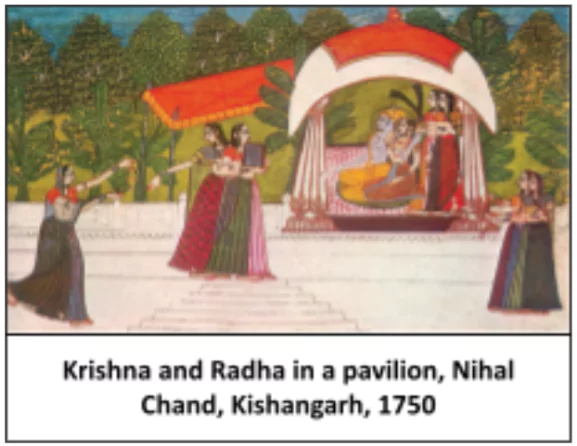Introduction
The Rajasthani School of Painting, originating in the royal courts of Rajasthan, India, is renowned for its vibrant colors, intricate details, and diverse themes reflecting local culture, mythology, and daily life
It flourished in the princely states and regions, primarily in modern-day Rajasthan and parts of Madhya Pradesh.
Development of Rajasthani Art
- Associated with the Rajput school of paintings.
- The ‘Ganga-Jamni’ cultural confluence in Sultanate courts influenced Rajasthani painting’s evolution.
- In the 16th century, ‘Western Indian’ and ‘Chaurapanchasika’ styles set the stage for 17th-century painting schools.
- Mughal artists migrated to Rajasthan and notable schools of painting emerged – Malwa, Mewar, Bundi-Kotah, Amber-Jaipur, Bikaner, Marwar, and Kishengarh.
Enroll now for UPSC Online Course
Features of Rajasthani Style
- Paintings were crafted on “waslis”, which are layered, thin sheets of handmade papers glued together for desired thickness.
- Mughal influence: Evident in improved drawing techniques and the introduction of naturalistic elements in figures and trees.
Prominent Schools
- Malwa: It presents a bridging of the styles of Jain manuscripts and Chaurpanchashika manuscript paintings.
- Themes are taken from Ramayana, Bhagavata Purana, Amaru Shataka, Rasikapriya, Ragamala, and Baramasa.
- Mewar: The Mewar School’s genesis is often linked to a set of Ragamala paintings from 1605 by Nisardin.
- In later periods it featured “tamasha” paintings that showcased court ceremonies and city views.
- Amber – Jaipur: It is believed that a school of painting originated at Amber, the old capital of the Amber State. Later on in the 18th century, the centre of artistic activity shifted to Jaipur, the new capital.
- Sawai Jai Singh (1699–1743): He established the city of Jaipur in 1727, shifting from Amer. During his reign, the Jaipur School thrived and became a distinct entity.
- He reorganised the Suratkhana (Painting department), the place for creating and storing paintings.
- He commissioned many paintings on Radha and Krishna themes.
- Sawai Pratap Singh (1779–1803): He marked a turning point where the dominant Mughal influence began to wane. He introduced a unique Jaipur style, blending Mughal and indigenous aesthetics.
- Marwar: This school encompasses regions like Jodhpur, Bikaner (Rathods), and Jaisalmer (Bhatis).
- Jodhpur, like Bikaner, prospered through its close ties with the Mughals.
- The prominent schools under the Marwar School umbrella are the Kishangarh School and the Bundi School.
 Kishangarh: Kishangarh paintings are among the most stylised Rajasthani miniatures.
Kishangarh: Kishangarh paintings are among the most stylised Rajasthani miniatures.-
- Under Man Singh’s patronage (1658–1706), a distinctive artistic style began to emerge in the Kishangarh court.
- This style was characterised by: an inclination to elongate human forms; a fondness for the colour green; and a preference for panoramic landscapes.
- Krishna Lila themes became the primary focus of Kishangarh art.
- Bundi School Of Painting: It is associated with the twin kingdoms of Bundi and Kota, collectively known as Hadoti. It witnessed its zenith in the 17th century.
- The early phase of Bundi painting is epitomized by the “Bundi Ragamala” from 1591. It had Persian inscriptions.
- Themes: Hunting-themed artworks, royal processions and Krishna’s tales.
- Bikaner: Bikaner’s painting style was influenced from Mughal style.
- A unique Bikaner practice was to include portraits of artists, often with inscriptions detailing their lineage.
- Such artists were titled “Ustas” or “Ustad”.
| ASPECT |
RAJPUT STYLE (17th-18th Century) |
MUGHAL STYLE (16th-18th Century) |
| Type |
- Initially based on mural and fresco forms. In the later period, the miniature painting form became dominant.
|
- It is based on the Persian miniature painting style.
|
| Themes |
- It is usually devotional or religious in nature.
|
- It usually depicts the Mughal emperor and his household. The royal pomp and show, the battles, and the hunting scenes are also very popular.
|
| Peculiarity |
- It uses Hindu symbols like the lotus, peacock, and swan very frequently.
|
- They focus either on the person in the picture or on trees, camels, and falcons.
|
Enroll now for UPSC Online Classes
Conclusion
- The Rajasthani School of Painting, with its distinctive styles like Mewar, Marwar, and Hadoti, showcases the region’s rich heritage and artistic prowess, enchanting viewers with its timeless beauty and narrative depth.
![]() April 18, 2024
April 18, 2024
![]() 2491
2491
![]() 0
0
 Kishangarh: Kishangarh paintings are among the most stylised Rajasthani miniatures.
Kishangarh: Kishangarh paintings are among the most stylised Rajasthani miniatures.